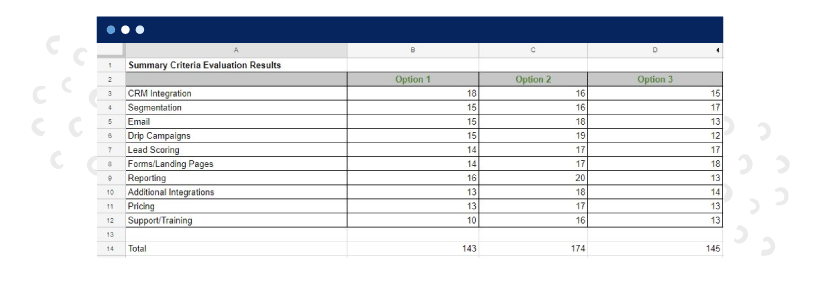As a marketing team, you want to make the most of digital data and leverage the online marketplace to the benefit of your business. Your software tools help you generate useful leads and find the customers who are looking for your products. They help you stay in the loop with up-to-date newsfeeds and ensure that your content is on point. These tools automate tasks and free up your time for more important things, like planning your new marketing strategy or brainstorming killer taglines.
Your set of software tools — your martech stack, if you will — is a good thing. But, as with everything in life, too much of a good thing can become, well, bad. While the average company has about 17 marketing technologies in use, few feel that their martech stack is truly integrated.
Martech has become essential to content marketing. In a recent study, 61 percent of respondents surveyed for our Martech Report 2022 agreed that martech sits at the heart of marketing strategy and is critical to meeting customer expectations.
Are you paying too much for too many different pieces of software? Do you sense that your martech stack has become bloated, and swollen with too many unnecessary items? Find out how you can conduct an effective audit of your martech stack, trim off that excess, and enjoy a freshly streamlined set of tools in 2024.
Steps For Auditing Your Martech Stack
1. List the software
The first step is to write down every single martech solution you have. Every piece of software from every part of your marketing department goes on the list. Dig into the software stashes of other departments to find out what software, new or old, they may have that relates to marketing needs.
In the process of making this list, you’ll probably realize that your martech stack is far more bloated than you thought. How many vendors are involved in your marketing department’s life right now? According to research, the average number of martech vendors per marketing department has risen dramatically in recent years.
Chances are, many of those vendors have come knocking on your department’s door, hence the martech bloat you are now facing as you stare at your list of software tools.
2. Understand the function
Once you’ve got your comprehensive list, find out what each kind of software does. You may need to do some research yourself or discuss the software with someone who uses it more often than you do. What’s important here is gaining a working knowledge of the function of the tool, so you can classify it.
3. Organize the stack
Now that you have your list of software tools, you need to organize your martech stack. Some experts suggest visually organizing your stack through a circuit board design or flow chart. Whether you use a visual design or a text-based approach, focus on getting the tools into the right categories. Which software solutions currently help you handle social media? Which ones assist with lead generation, customer retention, or content management? Sort your martech stack by the tasks it performs or by marketing trends it supports.
4. Evaluate the tools
Here’s the hard part. It’s time to evaluate every piece of software you have, based on its performance. You’re going to need some hard facts here, including key performance indicators specific to that martech solution’s function. For example, how many actionable, reliable leads did your lead-generation software yield in the past month or year? Do you have a duplicate tool that’s doing better? Perhaps there is new software on the market that could outperform your current system.
In creating an evaluation that is bias-free, it pays to go numerical. You’re going to need specific numbers here, not just general impressions; and it may take a while to get your hands on the concrete data. If it takes too long for your team to collect the necessary facts and figures, that may be a sign that your martech stack is neither as integrated or as effective as you hoped.
In building out a non-biased, numerical representation of the different tool options you’re using, I highly recommend you put your evaluation into a collaborative spreadsheet format, such as this one:
One company uses the following criteria to judge how well a martech tool is performing:
- How important is it to our business’s goals and operations?
- Does it meet the needs of users? Do our users understand and engage with it?
- How well does it generate/collect, use/transform, and organize/report data?
- How well does it protect data? What level of security is included with this tool?
- Will it be able to expand with our business as we grow?
- Does it integrate well with our other tools, data sources, or technologies?
Ask yourself and your team, “Does this tool exceed our expectations in a positive way? Do we use it regularly to solve our marketing problems?” If the answer is “no,” it may be time to look for a better solution.
5. Trim the excess
Once you’ve evaluated your software, let some of it go. It may be easy to rid your department of duplicate-function tools or older pieces of software that are obviously outdated, but it’s harder to cull the software that you selected yourself, or the tools that seem wonderful but are simply not as intuitive or usable as you thought they would be.
That’s where the data comes in. Your return on investment (ROI) is king here. If a piece of software isn’t functioning as well as promised, or if another tool can do the job better, the objective data is law. The hard facts help you stay fair and unbiased when you’re eliminating bloat.
6. Assess new products
While you’re kicking some of the older or less effective pieces of software to the curb, you’ll need to be looking for high-quality replacements. Ideally, you should be able to cull multiple tools and find one comprehensive solution to replace them.
There are over 11,000 martech tools available for marketers. It can be tough to find something that fits your business’s marketing strategy like a glove, but it’s possible.
Consult with other companies similar to yours; if they aren’t your direct rivals, they may be willing to tell you which solutions have worked for them. Browse online reviews and explore what the experts have to say about different pieces of software. Which ones have the highest ratings? Which ones offer the unique features or tools that would make your marketing efforts more powerful?
7. Communicate about the changes.
Make sure that everyone at your company is communicating effectively while you streamline the martech stack. The last thing you need is other departments going rogue and adding their own pieces of software, contributing to the bloat. Instead, create a central committee, testing group, or approval team that can accept software suggestions, check them out, and determine whether or not those tools would be valuable additions to the stack.
Consult with the legal department and with IT as well before you add a new marketing tool to your arsenal. Once the new software comes into play, be sure that everyone gets thorough training and understands how to make the most of your new martech solution.
Taking Your Martech Stack into 2024
The marketing technology landscape is shifting rapidly. If you’ve set up some business goals for the new year, add an audit of your tools to the list. A bloated martech stack can cost you time, money, and digital storage space (which also costs money). So take the opportunity to cull the unused or ineffective tools and replace them with a fully integrated, streamlined system of solutions that will give your business fresh marketing vigor.
And if you want to overhaul your tools and strategy, you’re not alone. At ClearVoice, our content creation services and expert team can ensure you have all the tools in place to ensure your business’s success. Talk to a specialist today.






